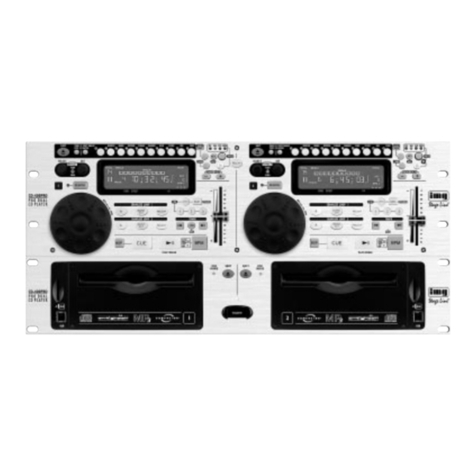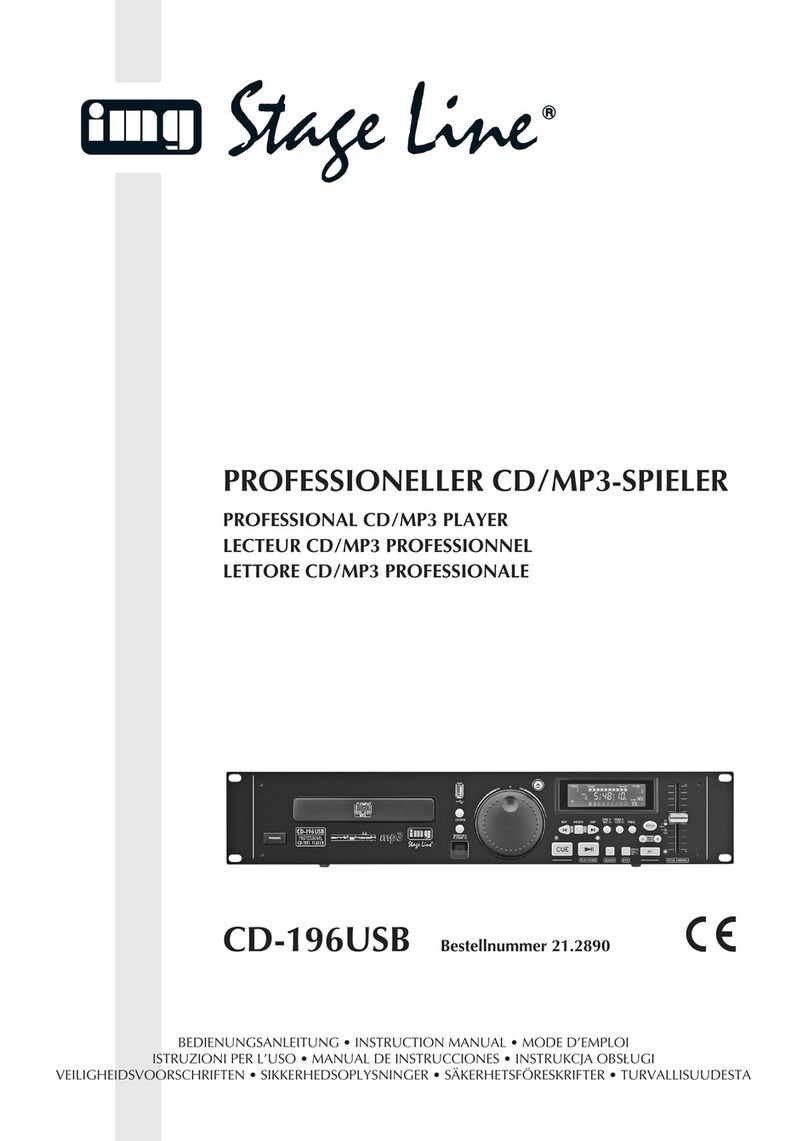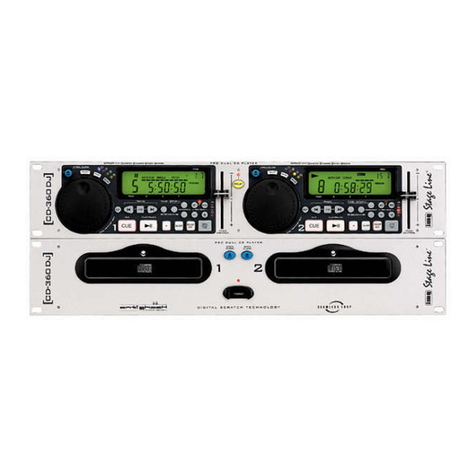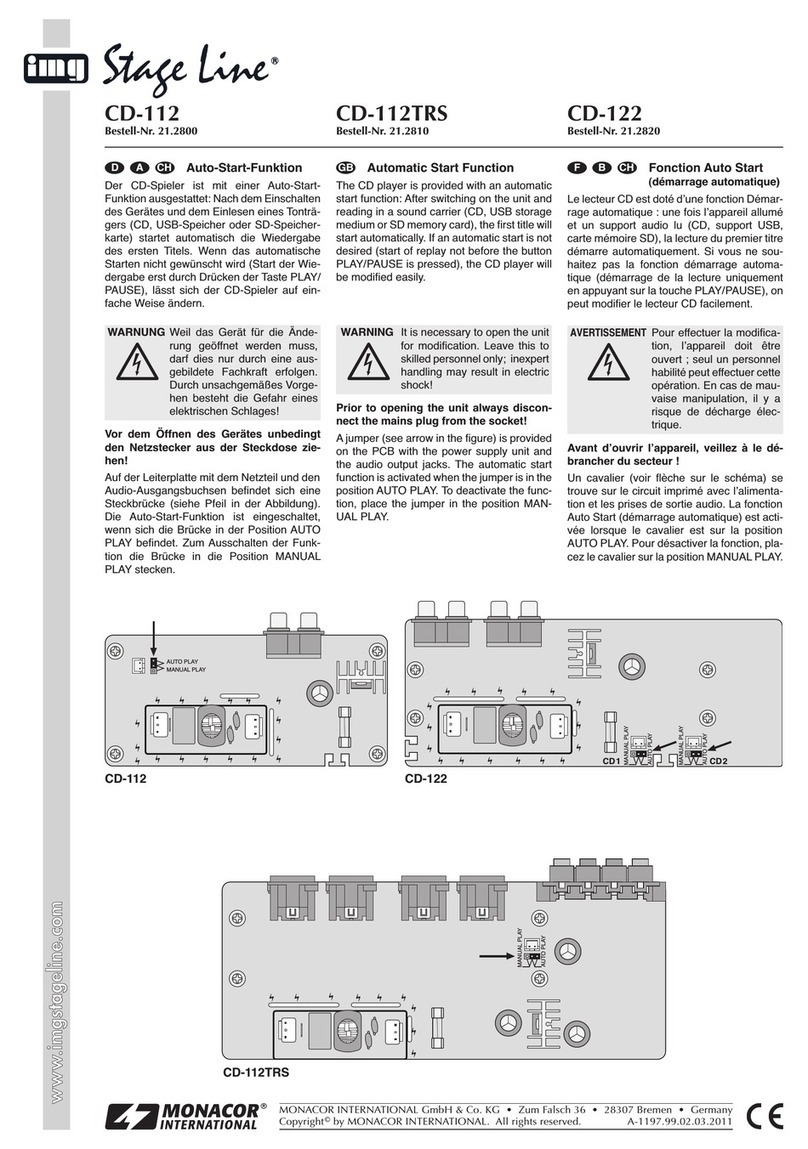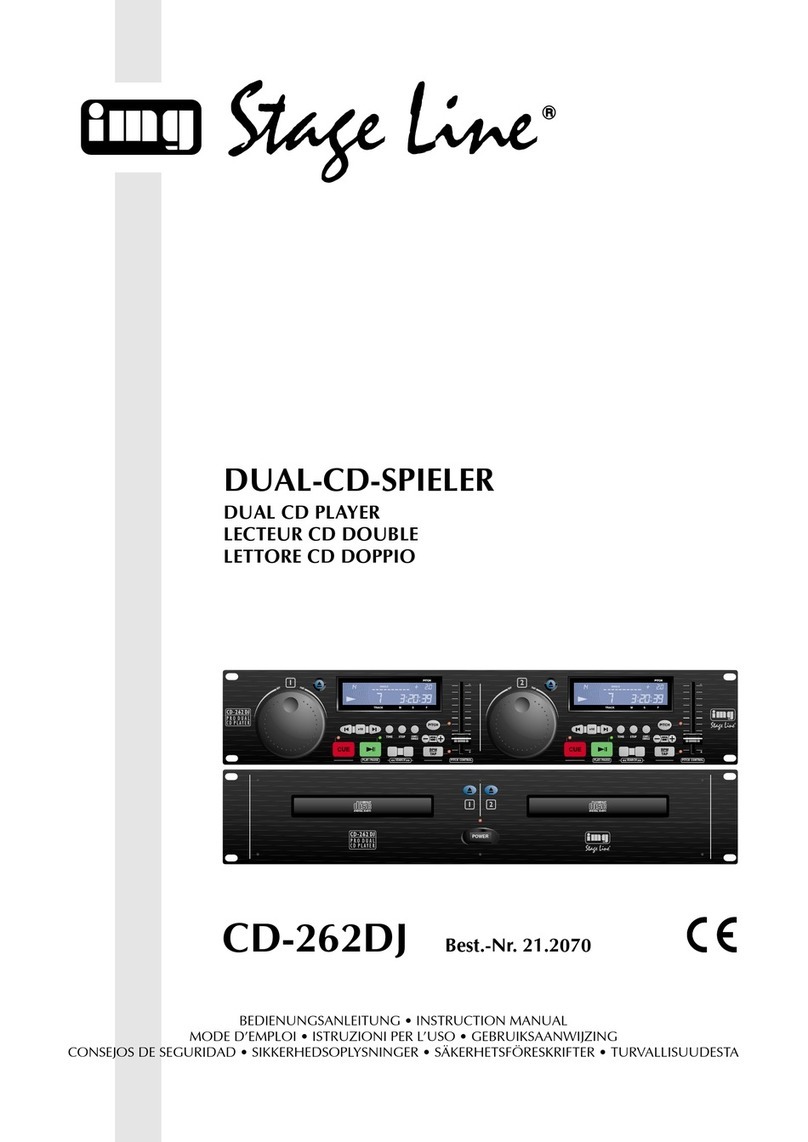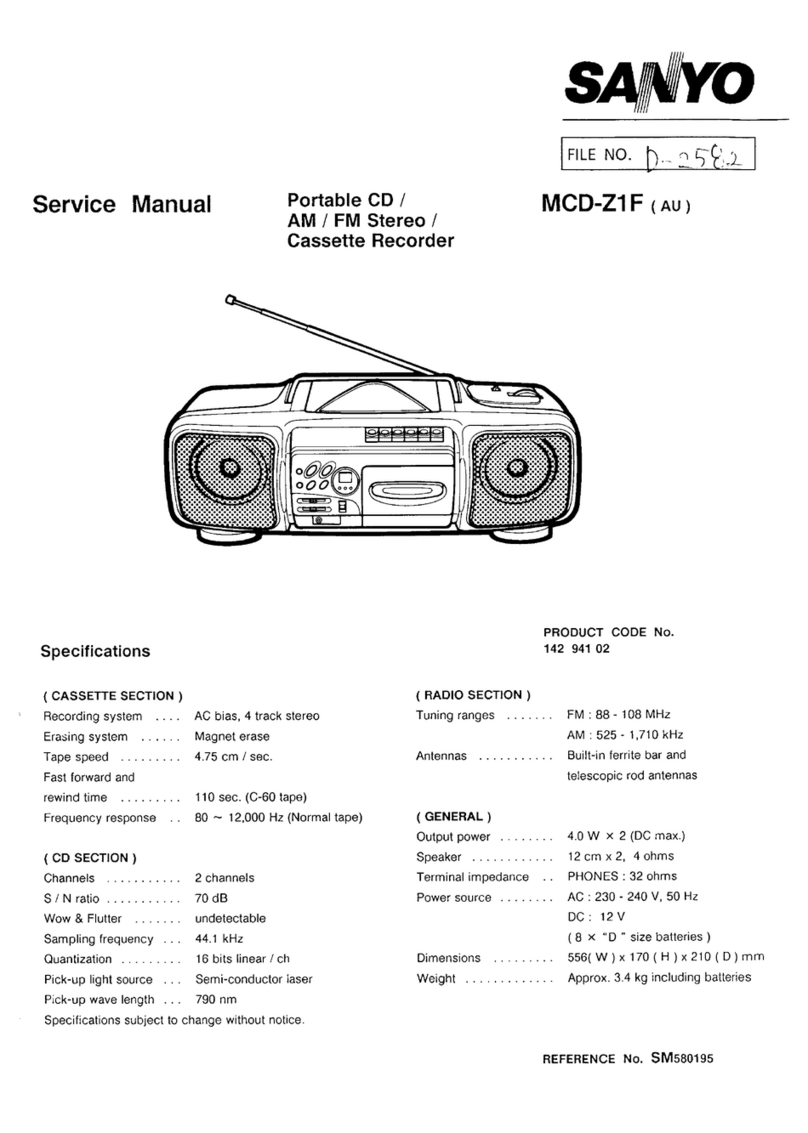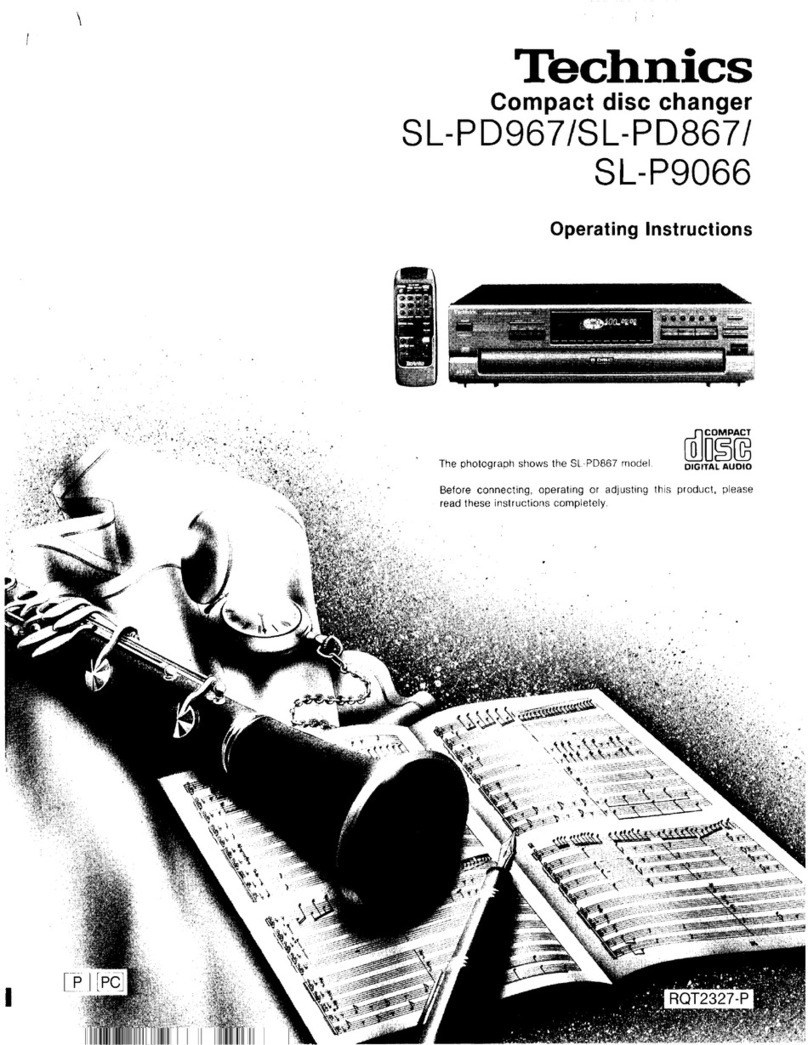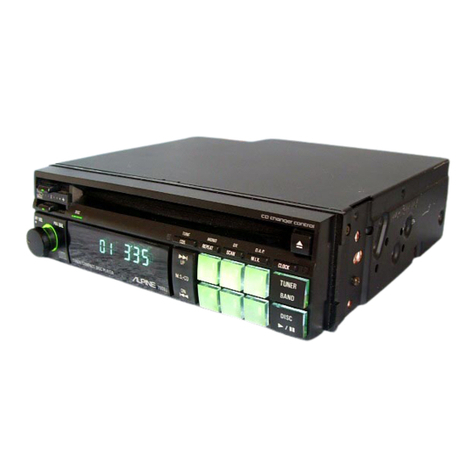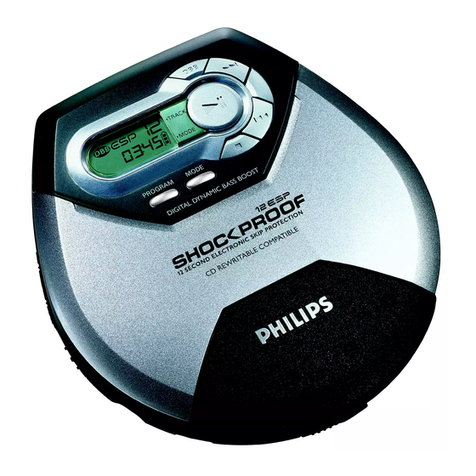Vor dem Anschluss bzw. vor dem Verändern von An-
schlüssen den CD-Player und die anzuschließen-
den Geräte ausschalten.
1) Ist an Ihrem Mischpult oder Verstärker ein Digital-
eingang vorhanden, diesen an den Digitalaus-
gang DIGITAL OUT (18) anschließen.
Bei Geräten ohne Digitaleingang den Stereo-
Ausgang LINE OUT (19) – linker Kanal L und
rechter Kanal R – über ein Cinch-Kabel mit
einem CD-Player-Eingang am Mischpult oder am
Verstärker verbinden.
2) Der CD-Player kann über ein Mischpult mit Fa-
derstart-Funktion ferngesteuert werden. Der An-
schluss der Steuerverbindung und die Art der
Fernsteuerung sind in Kapitel 6 erläutert.
3) Zuletzt den Netzstecker des Anschlusskabels
(22) in eine Steckdose (230 V~/50 Hz) stecken.
5 Bedienung
5.1 CD abspielen
1) Mit dem Ein-/Ausschalter POWER (1) den CD-
Player einschalten. Auf dem Display (5) erschei-
nen nacheinander folgende Anzeigen:
(schließen)
(lesen)
(keine CD) – wenn keine CD eingelegt ist
2) Mit der Taste (3) die CD-Schublade (2) öffnen.
Im Display erscheint (öffnen).
3) Eine CD mit der Beschriftung nach oben einlegen
und die CD-Schublade mit der Taste schlie-
ßen. Bei korrekt eingelegter CD gibt das Display
nach kurzer Zeit die Gesamttitelanzahl (f) und die
Gesamtspieldauer (g) der CD an und anschlie-
ßend die Spieldauer (g) des ersten Titels.
[Soll nach dem Einlegen der CD sofort der
erste Titel starten, die CD-Schublade mit der
Taste (10) schließen.]
4) Zum Starten mit dem ersten Titel die Taste
drücken (falls die CD-Schublade mit der Taste
geschlossen wurde). Solange die CD abgespielt
wird, zeigt das Display das Symbol (b).
Soll mit einem anderen Titel gestartet werden,
diesen über die Tasten , (4) oder +10 (9)
anwählen:
– Mit jedem Betätigen der Taste +10 erfolgt ein
Sprung über 10 Titel vorwärts.
– Durch Drücken der Taste wird immer ein
Titel weitergeschaltet. Beim Drücken der Taste
wird an den Anfang des gerade laufenden
Titels gesprungen. Durch mehrfaches Drü-
cken der Taste wird immer ein Titel weiter
zurückgesprungen. Zum Überspringen mehre-
rer Titel kann die Taste bzw. auch
gedrückt gehalten werden.
Danach den Titel mit der Taste starten.
5) Das Abspielen kann jederzeit mit der Taste
unterbrochen werden. Im Display erscheint das
Pausensymbol (a) und die LEDs über den
Tasten und CUE (8) blinken. Zum Weiterlau-
fen der CD die Taste noch einmal drücken.
6) Nach dem Einschalten steht das Gerät immer
auf Einzeltitelwiedergabe; das Display zeigt
„SINGLE AUTO CUE“ (d). Ist ein Titel zu Ende
gespielt, schaltet das Gerät am Anfang des näch-
sten Titels auf Pause. Soll jedoch automatisch
der nächste Titel gespielt werden, muss mit der
Taste CONT./SINGLE (14) auf Gesamttitelwie-
dergabe geschaltet werden (siehe auch Kapitel
5.3.2).
7) Soll das Abspielen einer CD vorzeitig beendet
werden, den CD-Player auf Pause schalten oder
mit der Taste STOP (13) das Laufwerk stoppen.
Die CD-Schublade kann nun mit der Taste
geöffnet werden.
Hinweis: Während der Wiedergabe ist die CD-
Schublade gegen unbeabsichtigtes Öff-
nen verriegelt.
8) Vor dem Ausschalten des Gerätes immer mit
der Taste die CD-Schublade schließen um
das Laser-Abtastsystem vor Verschmutzung zu
schützen. Erst dann das Gerät mit dem Ein-/Aus-
schalter POWER (1) abschalten.
5.2 Anzeige der Titelnummer, Laufzeit
und Taktschläge pro Minute
In der Grundeinstellung nach dem Einschalten gibt
das Display (Abb. 2) während der Wiedergabe einer
CD und bei eingeschalteter Pause die Nummer (f)
und die Restzeit (g) des gerade laufenden Titels an.
Zur Kennzeichnung der Restzeit signalisiert das
Display „REMAIN“ (i). Die Zeit wird in Minuten (M)
und Sekunden (S) angezeigt, wobei die Sekunden
noch einmal in 75 sogenannte „Frames” (F) unter-
teilt sind (1 Frame = 1/75 Sekunde).
5.2.1 Die Laufzeitanzeige umschalten
und die Funktion OUTRO aktivieren
Durch mehrfaches Betätigen der Taste TIME (11)
können folgende Zeitinformationen angezeigt und
die Funktion OUTRO gewählt werden:
1. Tastendruck: die bereits gespielte Zeit des laufen-
den Titels (die Anzeige „REMAIN“ erlischt)
2. Tastendruck: die Funktion OUTRO zum Abspielen
der jeweils letzten 30 Sekunden der weiteren
Titel (die Funktion ist erst ab dem nächsten Titel
aktiv – eventuell die Taste betätigen); die
Restzeit des laufenden Titels wird angezeigt
3. Tastendruck: die Restzeit der gesamten CD; die
Funktion OUTRO ist wieder deaktiviert
4. Tastendruck: Grundeinstellung (Anzeige der Rest-
zeit des laufenden Titels)
5.2.2 Bargraph
Der Bargraph (e) stellt die Titel- bzw. CD-Restzeit
oder die bereits gespielte Zeit eines Titels durch
seine Länge graphisch dar, je nachdem welche Zeit-
information im Display mit der Taste TIME (11) ge-
wählt wurde. Die letzten 30 Sekunden eines Titels
signalisiert der Bargraph durch Blinken in seiner
vollen Länge, wobei die letzten 15 Sekunden durch
ein schnelleres Blinken angezeigt werden.
5.2.3 Beatcounter
Mit dem manuellen Beatcounter lässt sich die An-
zahl der Taktschläge pro Minute (BPM = beats per
minute) des laufenden Titels feststellen:
However, in case of rewritable CDs (CD-RW) prob-
lems may arise while replaying depending on the
CD type, CD burner, and burning programme used.
4 Setting-up and Connecting the Unit
The CD player is provided for mounting into a rack
(482 mm/19″). For this purpose two rack spaces are
required (1 rack space = 44.45 mm). However, the
CD player can also be used as a table top unit. In this
case it must be placed on an even, horizontal sur-
face.
Prior to the connection or changing of connec-
tions switch off the CD player and the units to be
connected.
1) If a digital input is provided at your mixer or am-
plifier, connect it to the digital output DIGITAL
OUT (18).
In case of units without digital input connect
the stereo output LINE OUT (19) – left channel L
and right channel R – via a cable with phono con-
nectors to a CD player input at the mixer or ampli-
fier.
2) The CD player can be remote-controlled via a
mixer with fader start function. Information on the
connection of the control cable and type of
remote control can be found in chapter 6.
3) Finally connect the mains plug of the cable (22)
to a mains socket (230 V~/50 Hz).
5 Operation
5.1 Playing a CD
1) Switch on the CD player with the POWER switch
(1). The following indications are successively
displayed (5):
– if no CD has been inserted
2) Open the CD tray (2) with button (3). is
displayed.
3) Insert a CD with the lettering facing upwards and
close the CD tray with button . With the CD cor-
rectly inserted, after a short time the total number
of titles (f) and the total playing time (g) of the CD
are displayed and then the playing time (g) of the
first title.
[To start the first title immediately after inserting
the CD, close the CD tray with button (10).]
4) To start the first title, press button [if the CD
tray was closed with button ]. As long as the CD
is played, the symbol (b) is displayed.
To start with another title, select it via the but-
tons , (4) or +10 (9):
– Each time the button +10 is actuated, the unit
advances 10 titles.
– By pressing the button , the unit always
advances one title. By pressing the button ,
the unit goes to the beginning of the title cur-
rently playing. By pressing the button
repeatedly, the unit always returns one title. To
skip several titles, the button or can
also be kept pressed.
Then start the title with the button .
5) The playing can be interrupted any time with button
. The pause symbol (a) is displayed and the
LEDs above the buttons and CUE (8) flash. To
continue the CD, press button once again.
6) After switching-on, the unit is always set to single
title replay; “SINGLE AUTO CUE” (d) is displayed.
If a title is played to the end, the unit switches to
pause at the beginning of the next title. However,
for automatic playing of the next title, the unit
must be set to total title replay with button CONT./
SINGLE (14) [also see chap. 5.3.2].
7) To stop the CD replay at any time, set the CD
player to pause or stop the player mechanism
with the button STOP (13). The CD tray can now
be opened with button .
Note: While replaying, the CD tray is locked
against unintentional opening.
8) Prior to switching off the unit, always close the
CD tray with the button to protect the laser sys-
tem against impurities. Do not switch off the unit
with the POWER switch (1) before.
5.2 Display of title number, playing time,
and beats per minute
In the basic setting after switching-on, the number (f)
and the remaining time (g) of the currently playing
title are displayed (fig. 2) while replaying a CD and
with the pause mode activated. The display signal-
izes “REMAIN” (i) to indicate the remaining time.
The time is displayed in minutes (M) and seconds
(S), the seconds are again subdivided in 75 “frames”
(F) [1 frame = 1/75 second].
5.2.1 Switching over the display of the playing
time and activating the function OUTRO
By pressing button TIME (11) several times, the fol-
lowing time information and the function OUTRO
can be selected:
1st pressing of button: the time already played of the
current title (display “REMAIN” is extinguished)
2nd pressing of button: the function OUTRO for
playing in each case the last 30 seconds of fur-
ther titles (the function is only active as from the
next title – if required, press button ); the
remaining time of the current title is displayed
3rd pressing of button: the remaining time of the en-
tire CD; the function OUTRO is deactivated
again
4th pressing of button: basic setting (display of the
remaining time of the current title)
5.2.2 Bar graph
According to the time indication selected on the dis-
play with the button TIME (11), the bar graph (e)
shows graphically by its length the remaining time of
a title or CD or the time already played of a title. The
last 30 seconds of a title are indicated by the bar
graph flashing in its full length, the last 15 seconds
by even faster flashing.
6
GB
D
A
CH
